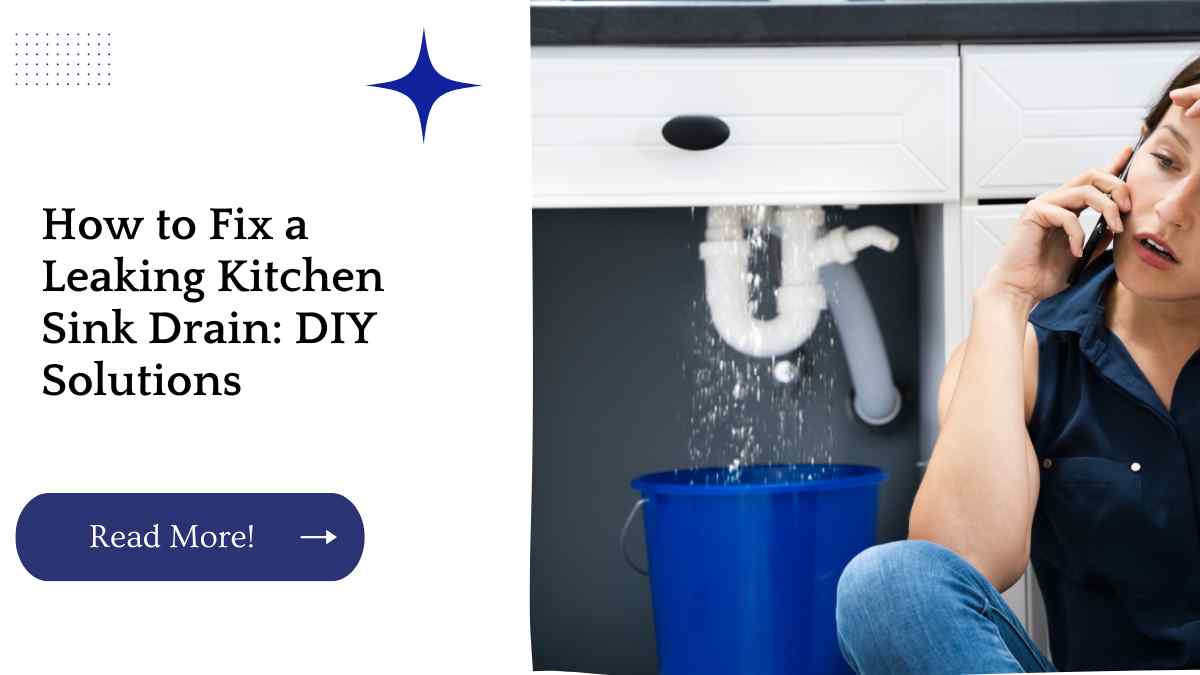If you notice water pooling around your kitchen sink, it may be a sign of a leaking drain. A leaking drain can cause water damage to your cabinets, floor, and walls. Fortunately, fixing a leaking kitchen sink drain is not as difficult as it may seem.
In this article, we will provide you with step-by-step instructions on how to fix a leaking kitchen sink drain on your own.
| Key Takeaways |
|---|
| You can fix a leaking kitchen sink drain on your own with the right tools and materials. |
| The most common causes of a leaking kitchen sink drain are a damaged basket strainer, a cracked drain pipe, or a faulty P-trap. |
| To fix a leaking kitchen sink drain, you need to first locate the source of the leak and then replace the damaged component. |
| Before you start working on your kitchen sink drain, you will need to turn off the water supply. |
| To prevent future leaks, make sure to clean your sink regularly, avoid using chemical drain cleaners, and tighten the slip nuts on the drain pipe and P-trap regularly. |
Tools and Materials Needed
Before you start fixing your leaking kitchen sink drain, you will need to gather the necessary tools and materials. Here’s a list of what you’ll need:
- Adjustable wrench
- Slip-joint pliers
- Putty knife
- Plumbers putty
- Plumbers tape
- Replacement basket strainer
- Replacement drain pipe
- Replacement P-trap
- Bucket
Preparation
Before you start working on your kitchen sink drain, you will need to turn off the water supply. Locate the shut-off valves under the sink and turn them clockwise to shut off the water. Once the water supply is turned off, you can start disassembling the drain.
If you want to make your kitchen more functional and beautiful, check out our article on DIY Under Cabinet Lighting Installation. It provides some practical tips that can help you illuminate your kitchen while adding a touch of elegance and style.
Locating the Leak
The first step in fixing a leaking kitchen sink drain is to locate the source of the leak. The most common causes of a leaking kitchen sink drain are a damaged basket strainer, a cracked drain pipe, or a faulty P-trap.
Use a putty knife to scrape away any old plumbers putty around the drain. Once the putty is removed, inspect the drain for any visible signs of damage.
Replacing the Basket Strainer
If the basket strainer is damaged or worn out, it will need to be replaced. Use slip-joint pliers to loosen the locknut on the bottom of the sink.
Once the locknut is removed, you can pull out the old basket strainer. Clean the sink opening and apply a new layer of plumbers putty around the opening. Insert the new basket strainer and tighten the locknut.
Replacing the Drain Pipe
If the drain pipe is cracked or damaged, it will need to be replaced. Use an adjustable wrench to loosen the slip nuts on either end of the drain pipe. Once the slip nuts are removed, you can pull out the old drain pipe. Insert the new drain pipe and tighten the slip nuts.
Need to upgrade or reinstall your garbage disposal? Our article on Upgrade Your Garbage Disposal: DIY Installation Tips provides some useful tips on how to accomplish this task without hiring a professional plumber. This can save you time and money.
Replacing the P-Trap
If the P-trap is the cause of the leak, it will need to be replaced. The P-trap is the curved pipe that connects the drain pipe to the main drain line. Loosen the slip nuts on either end of the P-trap using slip-joint pliers or an adjustable wrench.
Once the slip nuts are removed, you can pull out the old P-trap. Insert the new P-trap and tighten the slip nuts.
Reinstalling the Drain Pipe
Once you have replaced the damaged component, you can start reassembling the drain pipe. Apply plumbers tape to the threads of each slip nut to create a watertight seal. Insert the slip nuts back onto the drain pipe and tighten them using slip-joint pliers or an adjustable wrench.
Dealing with a slow draining kitchen sink? Our article on No More Grease Buildup: Cleaning Your Kitchen Drain provides some tips on how to clean and maintain your kitchen drain, thereby preventing grease buildup and other related problems.
Testing the Drain
Before you turn the water supply back on, it’s important to test the drain for any leaks. Place a bucket underneath the drain and turn on the water supply.
Let the water run for a few minutes and check for any leaks around the drain. If you don’t see any leaks, you can turn off the water supply and remove the bucket.
Tips for Preventing Future Leaks
To prevent future leaks, there are a few things you can do. First, make sure to clean your sink regularly to prevent buildup of food particles and other debris.
This can cause the drain to clog and lead to leaks. Second, avoid using chemical drain cleaners as they can damage the pipes and cause leaks. Finally, make sure to tighten the slip nuts on the drain pipe and P-trap regularly to prevent them from loosening over time.
The importance of a properly leveled toilet cannot be overstated. Check out our article on The Importance of a Level Toilet: Here’s Why to learn more about the benefits of leveling your toilet and how to accomplish this task without spending a lot of money.
Further Reading
Here are some additional resources you may find helpful:
How to Fix a Leaky Sink Drain Pipe: This WikiHow article provides a comprehensive guide to fixing a leaky sink drain pipe. The article includes detailed instructions and helpful illustrations.
How to Fix Sink Strainers: This Home Depot guide provides information on how to fix sink strainers, including basket strainers and pop-up stoppers. The guide includes step-by-step instructions and helpful tips.
Conclusion
Fixing a leaking kitchen sink drain is not as difficult as it may seem. With the right tools and materials, you can easily replace the damaged component and prevent further damage to your cabinets, floor, and walls.
Remember to always turn off the water supply before working on your kitchen sink drain, and test the drain for leaks before turning the water back on. By following these steps, you can successfully fix a leaking kitchen sink drain on your own.
We all encounter common household problems, and your refrigerator is no exception. Our article on Troubleshooting Common Refrigerator Problems: DIY Fixes provides some useful tips on how to troubleshoot and fix some of the most typical problems you may encounter with your refrigerator
FAQs
How do I know if my kitchen sink drain is leaking?
You may notice water pooling around your kitchen sink or a musty smell coming from your cabinets. Inspect the drain for any visible signs of damage or call a plumber if you’re unsure.
Can I use chemical drain cleaners to fix a leaking kitchen sink drain?
It’s best to avoid using chemical drain cleaners as they can damage the pipes and cause leaks. Instead, try using a plunger or a drain snake to remove any clogs.
How often should I tighten the slip nuts on my kitchen sink drain?
It’s a good idea to check the slip nuts on your kitchen sink drain and P-trap regularly and tighten them as needed. This can prevent them from loosening over time and causing leaks.
What should I do if I can’t fix my leaking kitchen sink drain on my own?
If you’re unable to fix your leaking kitchen sink drain on your own, it’s best to call a licensed plumber. They can diagnose the problem and provide you with a solution.
How can I prevent future leaks in my kitchen sink drain?
To prevent future leaks, make sure to clean your sink regularly, avoid using chemical drain cleaners, and tighten the slip nuts on the drain pipe and P-trap regularly.

Hellen James is the author of the blog and a licensed plumber with over 15 years of experience. She shares her knowledge and experience in plumbing and drainage through insightful and informative articles

